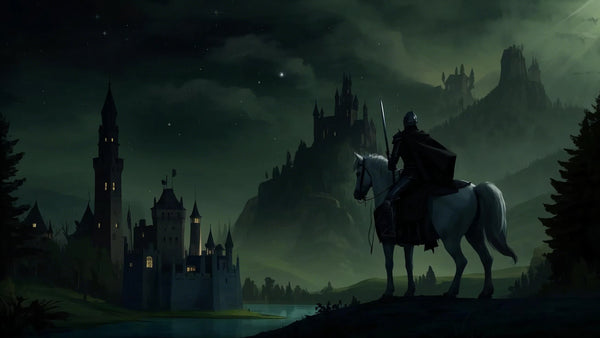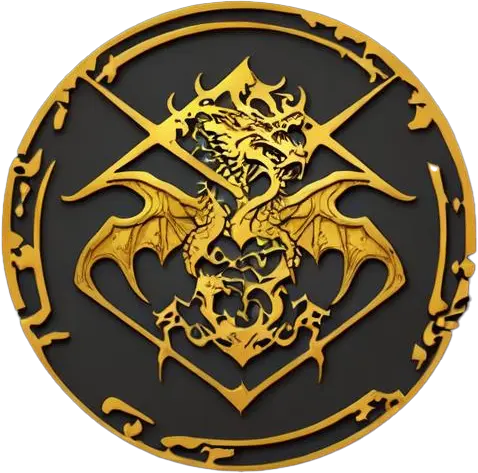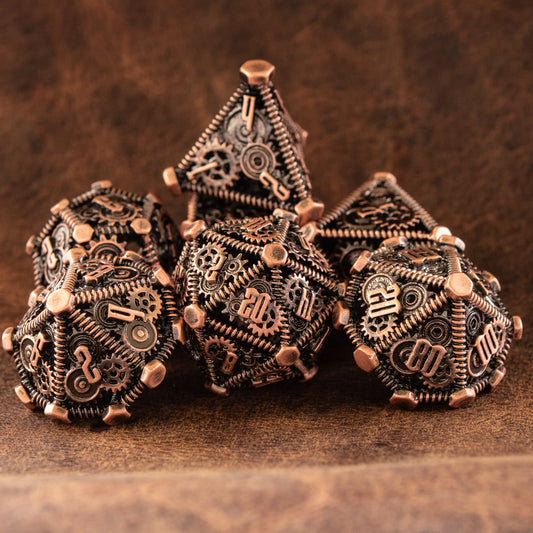How to Draw DnD Dice: A Comprehensive Guide for Dungeons & Dragons Players
Share
How to Draw DnD Dice: A Comprehensive Guide for Dungeons & Dragons Players
Introduction
Dungeons & Dragons (D&D) is a game that has captivated the imaginations of players for decades. Central to the game are the iconic polyhedral dice, which add an element of chance and excitement to every session. For many players, the allure of these dice extends beyond gameplay, sparking an interest in drawing and designing their own. In this guide, we'll explore how to draw DnD dice, providing a step-by-step approach that will help you create your own artistic renditions of these essential gaming tools.
Section 1: Understanding DnD Dice
1.1 Overview of DnD Dice
DnD dice are not just ordinary dice; they come in various shapes and sizes, each serving a unique purpose in the game. These dice are known collectively as polyhedral dice, and they are a fundamental part of the D&D experience.
1.2 Types of DnD Dice
- d4 (Four-Sided Die): Shaped like a pyramid, the d4 is often used for determining damage from small weapons or spells.
- d6 (Six-Sided Die): The most familiar type of die, used for a wide range of actions, including ability checks and damage rolls.
- d8 (Eight-Sided Die): Commonly used for weapon damage and hit points.
- d10 (Ten-Sided Die): Utilized for percentile rolls and certain damage calculations.
- d12 (Twelve-Sided Die): Less common but used for specific weapon damage and other game mechanics.
- d20 (Twenty-Sided Die): The quintessential D&D die, used for attack rolls, saving throws, and skill checks.
1.3 Importance of Dice in Dungeons & Dragons
Dice are integral to D&D, determining the outcomes of players' actions and the narrative direction of the game. They embody the unpredictability and excitement that make each session unique.
Section 2: Materials Needed for Drawing DnD Dice
2.1 List of Art Supplies
- Pencils (HB, 2B, 4B)
- Erasers (kneaded and standard)
- Ruler
- Compass
- Protractor
- Fine liner pens
- Colored pencils or markers
2.2 Choosing the Right Paper and Pencils
For the best results, use high-quality drawing paper that can handle multiple layers of shading and erasing. A range of pencils from HB to 4B will allow you to create precise lines and rich shading.
2.3 Optional Tools for Enhancing Your Drawing
- Blending stumps for smooth shading
- Lightbox for tracing
- Digital drawing tablet for those who prefer digital art
Section 3: Basic Drawing Techniques
3.1 Understanding Basic Shapes and Geometry
Drawing DnD dice begins with mastering basic geometric shapes. Each die is based on a simple polygon, and understanding these shapes is crucial for accurate drawing.
3.2 Drawing 3D Shapes and Perspective
To give your dice a realistic look, practice drawing 3D shapes using perspective techniques. Start with cubes and pyramids, and gradually move on to more complex polyhedra.
3.3 Practicing with Simple Dice Shapes
Begin by drawing basic shapes like cubes (for d6) and pyramids (for d4). Focus on getting the proportions and angles correct before adding details.
Section 4: Step-by-Step Guide to Drawing a D20
4.1 Step 1: Drawing the Basic Outline
Start by drawing a circle and dividing it into 20 equal sections using a protractor. Connect the points to form the triangular faces of the d20.
4.2 Step 2: Adding Faces and Numbers
Number each face of the d20, ensuring that opposite faces add up to 21. Use a fine liner pen to outline the faces and numbers for clarity.
4.3 Step 3: Shading and Detailing
Add shading to give your d20 depth and dimension. Focus on the light source and create shadows accordingly. Use blending stumps to smooth out the shading.
4.4 Common Mistakes to Avoid
- Incorrect proportions: Ensure all faces are equal.
- Misnumbering: Double-check the placement of numbers.
- Over-shading: Keep the shading consistent with the light source.
Section 5: Drawing Other Polyhedral Dice
5.1 Drawing a D4
Start with a triangular base and extend lines to form a pyramid. Number each face from 1 to 4.
5.2 Drawing a D6
Draw a cube and add numbers to each face, ensuring opposite faces add up to 7.
5.3 Drawing a D8
Create two squares rotated 45 degrees to each other and connect the corners to form an octahedron. Number the faces accordingly.
5.4 Drawing a D10
Draw two pentagons, one slightly smaller than the other, and connect their vertices. Add numbers from 0 to 9.
5.5 Drawing a D12
Construct a dodecahedron by drawing 12 pentagonal faces. Number each face from 1 to 12.
By following these steps and practicing regularly, you'll be able to draw DnD dice with precision and creativity. Whether you're a player looking to add a personal touch to your game or an artist seeking new challenges, drawing DnD dice is a rewarding endeavor that combines art and imagination.
Advanced Techniques for Realistic Dice Drawings
Adding Realistic Textures
To elevate your drawings of DnD dice, incorporating realistic textures is essential. Here’s how you can achieve this:
- Study Real Dice: Examine different sets of DnD dice to understand their textures. Pay attention to the material, whether it’s plastic, metal, or gemstone.
- Use Reference Images: Keep high-resolution images of dice handy. These will serve as a guide for adding textures like scratches, marbling, or glitter.
- Layering Techniques: Start with a base color and gradually add layers of texture. Use a combination of pencils, pens, and blending tools to create depth.
- Highlight and Shadow: Accentuate the texture by adding highlights and shadows where light naturally hits and where shadows fall.
Using Light and Shadow for Depth
Creating a sense of depth in your dice drawings can make them appear more three-dimensional and lifelike. Here’s how:
- Determine Light Source: Decide where the light is coming from in your drawing. This will guide where you place your highlights and shadows.
- Gradual Shading: Use a gradient technique to transition smoothly from light to dark areas. This can be achieved with pencils or digital shading tools.
- Cast Shadows: Don’t forget to include cast shadows on the surface where the dice rest. This adds to the realism and helps ground the dice in the scene.
- Reflective Surfaces: If your dice are made of a reflective material, like metal, use sharp highlights and dark shadows to mimic the reflective quality.
Creating a Glossy Finish
A glossy finish can make your dice drawings pop. Here’s a step-by-step guide:
- Base Layer: Start with a smooth, even base layer of color.
- Highlight Placement: Add small, bright highlights to areas where the light hits directly. Use white or a very light color.
- Blending: Blend the highlights into the base color smoothly. This can be done with blending stumps or digital tools.
- Reflections: Add subtle reflections of the surrounding environment if the dice are very glossy. This adds an extra layer of realism.
Digital Drawing of DnD Dice
Introduction to Digital Art Tools
Digital art tools can significantly enhance your ability to draw DnD dice. Here are some popular tools:
- Software: Programs like Adobe Photoshop, Procreate, and Clip Studio Paint offer robust features for drawing and shading.
- Hardware: A graphics tablet, such as a Wacom, can provide precision and control that’s hard to achieve with a mouse.
- Brushes: Utilize different brush settings to mimic traditional art tools. Custom brushes can also be downloaded or created to suit your needs.
Step-by-Step Guide for Digital Drawing
- Sketching: Start with a basic sketch of your dice. Use layers to separate different elements of your drawing.
- Inking: Outline your sketch with a clean, smooth line. Digital tools allow for easy adjustments and corrections.
- Base Colors: Fill in the base colors on a new layer beneath your inked lines.
- Shading and Highlights: Add layers for shading and highlights, using blending modes to achieve the desired effect.
- Textures: Apply textures using texture brushes or overlay layers to add realism.
Tips for Digital Shading and Coloring
- Layer Management: Keep your layers organized. Name them appropriately and group similar elements together.
- Blending Modes: Experiment with blending modes like Multiply for shadows and Overlay for highlights to achieve different effects.
- Color Palettes: Use consistent color palettes to maintain a cohesive look. Tools like Adobe Color can help you create and manage palettes.
- Zoom and Detail: Zoom in to add fine details and zoom out to check the overall composition regularly.
Inspiration and Ideas
Exploring Different Art Styles
Experimenting with different art styles can help you find your unique voice as an artist. Consider these styles:
- Realism: Focus on lifelike representations with detailed textures and shading.
- Cartoon: Simplify shapes and use bold lines and vibrant colors.
- Fantasy: Incorporate fantastical elements like magical glows or ethereal textures.
Incorporating Dice into Larger Art Pieces
Dice can be a focal point or a subtle element in larger compositions. Here are some ideas:
- Character Portraits: Include dice as part of a character’s gear or in the background.
- Battle Scenes: Use dice to represent spells or abilities in action.
- Still Life: Create a still life composition featuring dice and other DnD-related items.
Showcasing Your Work on Social Media
Sharing your artwork on social media can help you connect with other artists and DnD enthusiasts. Here’s how to do it effectively:
- Platforms: Use platforms like Instagram, Twitter, and DeviantArt to reach a broad audience.
- Hashtags: Use relevant hashtags like #DnDArt, #DiceDrawing, and #DungeonsAndDragons to increase visibility.
- Engagement: Engage with your audience by responding to comments and participating in art challenges or collaborations.
Troubleshooting Common Issues
Fixing Proportion Errors
Proportion errors can detract from the realism of your dice drawings. Here’s how to fix them:
- Guidelines: Use guidelines to ensure consistent proportions.
- Reference Checks: Regularly compare your drawing to reference images.
- Adjustments: Don’t be afraid to make adjustments as you go. Digital tools make it easy to resize and reshape elements.
Correcting Perspective Mistakes
Perspective mistakes can make your dice look flat or distorted. Here’s how to avoid them:
- Vanishing Points: Use vanishing points to guide your perspective lines.
- Practice: Regularly practice drawing basic shapes in perspective to build your skills.
- Tools: Use perspective grids or rulers in digital art programs to maintain accuracy.
Improving Shading Techniques
Shading can make or break the realism of your drawing. Here’s how to improve:
- Light Source: Always keep the light source in mind when shading.
- Gradient Practice: Practice creating smooth gradients to improve your shading transitions.
- Feedback: Seek feedback from other artists to identify areas for improvement.
Conclusion
Drawing DnD dice is a rewarding skill that can enhance your enjoyment of Dungeons & Dragons and improve your overall artistic abilities. By mastering both traditional and digital techniques, you can create stunning, realistic dice drawings. Remember to practice regularly, experiment with different styles, and share your work with the community. For further learning, explore the recommended resources below.
Resources and Further Learning
Recommended Books and Tutorials
- "Drawing for the Absolute and Utter Beginner" by Claire Watson Garcia
- "Figure Drawing for All It's Worth" by Andrew Loomis
- Online tutorials on platforms like YouTube and Skillshare
Online Courses and Workshops
- Udemy: Offers various courses on drawing fundamentals and digital art.
- Coursera: Provides courses from top universities on art and design.
- Domestika: Features workshops by professional artists on specific techniques.
Communities and Forums for Artists
- DeviantArt: A platform for sharing and discussing artwork.
- Reddit: Subreddits like r/DnD and r/ArtCrit offer feedback and inspiration.
- Discord: Join art-focused servers to connect with other artists and participate in challenges.
By utilizing these resources and continually honing your skills, you’ll be well on your way to mastering the art of drawing DnD dice. Happy drawing!


